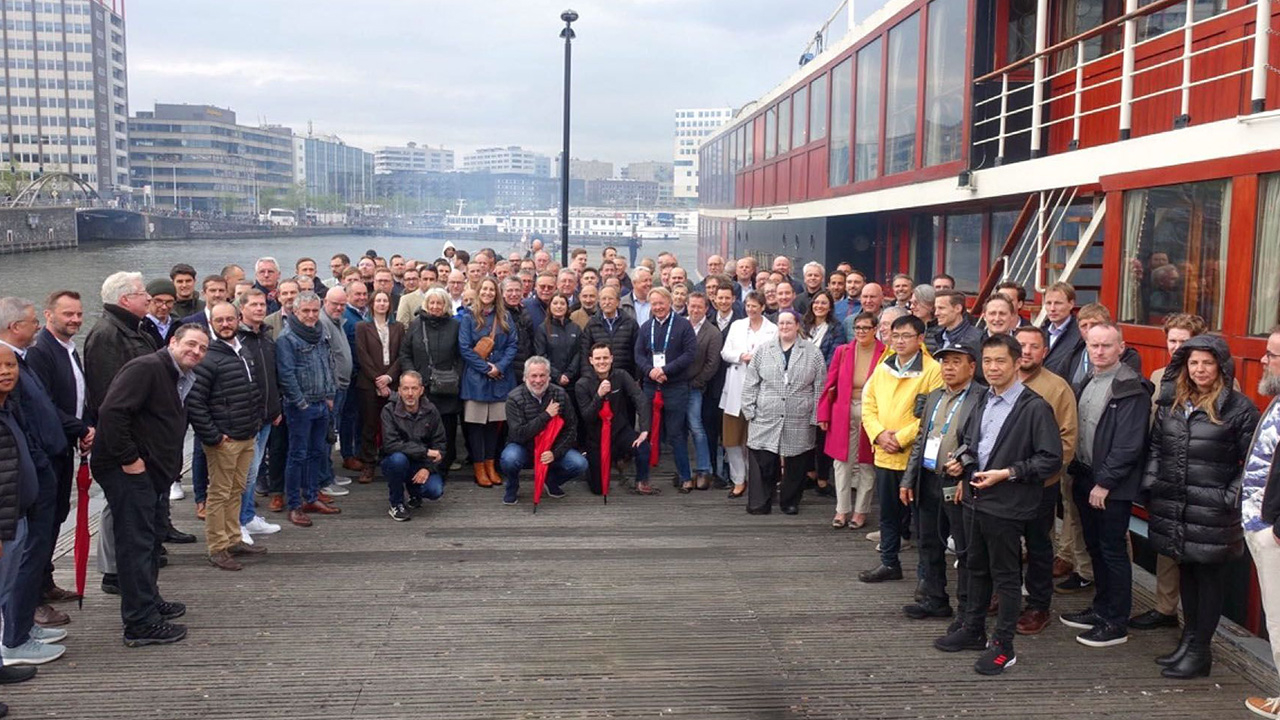Labelexpo Europe 2011 review: Pre-press

Developments in direct plate imaging and workflow automation were among key pre-press advancements at Labelexpo Europe, as Andy Thomas reports
Direct imaging
Direct imaging of flexo plates holds the potential to reduce the number of processing steps in plate production – simply imaging followed by rinse and dry - and to give unprecedented control over dot size and shape on different areas of the plate. This Labelexpo saw the introduction by Kodak to the packaging market of its Flexcel Direct laser plate engraving system. This consists of imager, plate material – suitable for both solvent and water-based inks - and 3-D workflow software. The system can be used to image continuous sleeve, plate-on-sleeve or flat plates, and will also image LAMS plates and sleeves.
The imaging unit utilizes Kodak’s proven multi-channel laser diode array, claimed by Kodak 4-6 times more energy efficient than traditional lasers with one third the chilling requirements.
Autofocus optics tracks media surface during engraving to maximize engraving consistency and there is an integrated evacuation system for elastomer debris collection.
Cantilever sleeve loading allows for fast and easy sleeve exchange and users can change between mandrel and vacuum drum without the need of an overhead crane.
Maximum imaging width is 1.6 m and maximum repeat 1067 mm.
Fujifilm was discussing the latest developments in its Flenex DLE flexo plate engraving technology, first covered by L&L at Labelexpo Americas. The Flenex DLE system incorporates FujFilm’s multi-channel FC laser array platesetter and the company’s own polymer plate material.
According to the company’s John Davies, business strategy manager at FujiFilm Europe, the DLE system should be commercialized some time in the first half of next year. ‘Our starting point is to image a B2 sheet in around 50 minutes, meaning a plate for a Gallus EM280 would take one third of that time. And we expect these times to come down as we move forwards.’
Stork is a supplier with a long history direct engraving system development and was showcasing its rotaLEN engraver for in-the-round processing of RotaMesh and RotaPlate screens and compact rotaLEX, a compact and inexpensive desk-top unit which uses laser exposure to engrave RotaPlate screens held in position on a magnetic drum. Another established player in the direct engraving market is Flexolaser, which was demonstrating its established Nano and Piccolino systems. With plate sizes of 508 x 420 mm and 635 x 500 mm respectively, these are targeted squarely at the label and narrow web printer. The front end Multiplate software allows easy and intuitive job setup and the vacuum slider and mechanical clamping system help speed up plate mounting.Lüscher meanwhile launched its new X!Direct system for the direct exposure of letterpress plates without an ablation layer.
Inkjet CTP
An interesting challenge to established CTP technologies came from Israeli company Digiflex layed down a challenge to existing CTP technologies with the launch of its FlexoJet 1724 plate imager. The FlexoJet consists of a high precision flatbed inkjet printer, patented Bi-component ink and the software to create an opaque mask on top of
the plate.
After the image has been printed onto the plate, the rest of the plate-making process remains unchanged from standard water or solvent wash processes. Digiflex says the FlexoJet gives better results than low-quality negative films, and offers an alternative to black mask ablation CTP devices. The resolution of the printer is 2880 x 1440 dpi and it will produce plates up to a
180 LPI line screen.
‘This is a revolutionary CtP solution, transforming the quality of analog photopolymeric plates for the flexographic, letterpress and dry-offset printing technologies, to the digital era,’ said Adir Ariel, DigiFlex’ director of sales and marketing Europe,
Maximum plate size is 440mm x 640mm and imaging speed for a full plate is 22 minutes, or 6.5 minutes for an A4 size.
Just before the show, Digiflex announced a distribution agreement with Jet Europe, whose md Harry Heesen commented: ‘This FlexoJet 1724 Computer-to-Plate system serves as a great motivation to replace the low quality film solution and will bring the CtP world
to everyone.’
Workflow automation
As the labels industry becomes more automated and industrialized, automation of workflow and the connecting label converters to the wider world of design and end user approval cycles becomes ever more important.
EskoArtwork has led the way in many of these developments, and this show saw the company consolidating across its full suite of plate preparation and workflow software.
Fresh from winning the Global Label Award for New Innovation for its HD Flexo 2 suite, the company demonstrated the software’s improved screening algorithms - particularly impressive in combination with the new flat top dot, and significantly improving print definition. The new inline UV exposure unit for Cyrel Digital Imagers offers flexo printers the flexibility to select the type of print dot – either round-top or flat-top – according to the specific job requirement.
EskoArtwork continues to refine its System 10 tool set. One of the standout demonstrations was the Studio Toolkit for Labels, which allows artworkers to prototype designs in a 3D environment. The latest development is Store Visualizer which allows users to envision realistic store shelves simulations, based on the same designs produced in Studio and Visualizer.
In a related development, the latest release of WebCenter (10.1) now includes a 3D viewer which enables users to upload, view and perform the full document approval cycle on 3D files (Collada and Zipped Collada files). Label converters will now be able use WebCenter as an online medium to share 3D mockups with their clients, make changes to the artwork immediately and gain approval quickly and efficiently.
WebCenter 10.1 also supports an iPad App which allows users to view, annotate and approve packaging designs through a simple and intuitive interface. The App gives users access to advanced tools such as separation views, ink details, and CAD overlays; dimensions can be measured and document history consulted. Differences in multiple versions can be highlighted with a compare tool.
In an announcement of interest to Nexus users, EskoArtwork confirmed that System 10’s Automation Engine now also fully integrates with its legacy label pre-production workflow, which should allow seamless transition to the new system.
EskoArtwork was also demonstrating the latest CDI device on its stand, and in a related development, DuPont Graphics made some interesting comments on the future of in-the-round thermal processing of sleeves, which we cover in more detail in the next edition of L&L.
It’s fair to say that Kodak somewhat lost its way with the labels and the narrow web packaging audience after its acquisition of Creo, which had always been a strong player in this segment. However, all that has clearly changed, and Kodak came to this show with all guns blazing and a clear sense of commitment to the narrow web packaging industry.
Firstly the company ran a series of engaging ‘K-Zone’ educational seminars on stand which drove home the theme of ‘Concept to Consumer’ through a mixture of moderated customer roundtables and technical discussions.
For brand owners Kodak was showing its DESIGN2LAUNCH package for improving efficiency and reducing costs and its Brand Protection Solutions suite of products to protect, track and secure high value products in the field. This sensitive area is a growing business for Kodak, according to David Croft, Kodak’s packaging segment manager.
For converters, Kodak demonstrated its full range of plates and platemaking technologies (see Engraving section above), including the established Flexcel NX, Miraclon letterpress and offset plates, as well as the latest version of Prinergy Powerpack workflow and packaging layout automation software. Kodak Insite was demonstrated providing secure web access for remote job submission, progress tracking and approval.
A particularly interesting development was the extension of Kodak’s Spotless technology to the flexographic process. Spotless allows printers to replace spot colors with recipes for four color process printing, reducing press downtime from cleaning up solid color units and allowing designers and print buyers to specify a greater variety of spot colors at no additional cost. The ability to deliver spot color value with extended process color builds also allows printers to combine jobs that traditionally required separate print runs.
Expect to see these developments covered in more detail in next year’s edition of L&L.
Pictured: Dantex displayed a range of high resolution water wash plate technologies
This article was published in L&L issue 6, 2011
Stay up to date
Subscribe to the free Label News newsletter and receive the latest content every week. We'll never share your email address.


